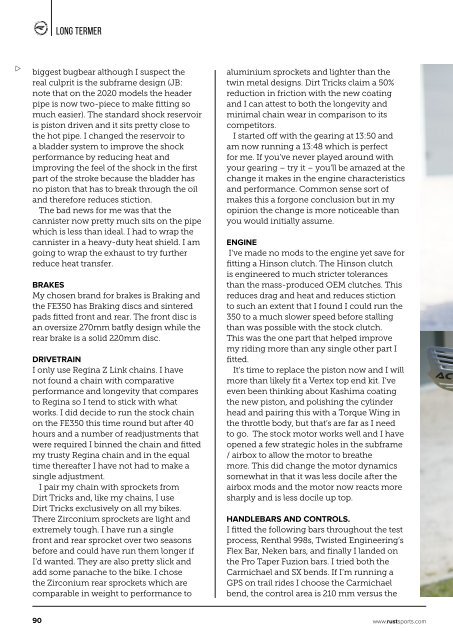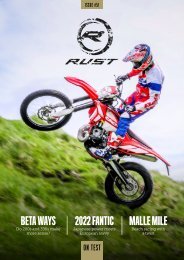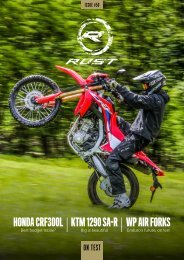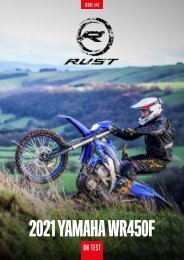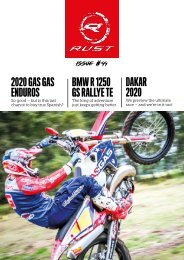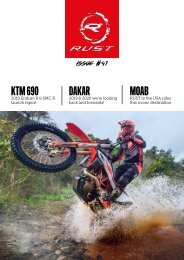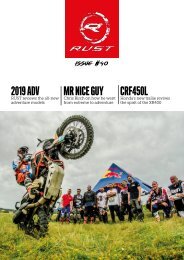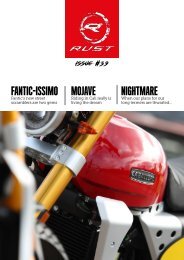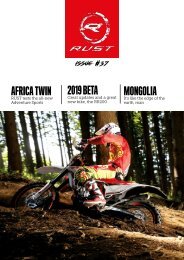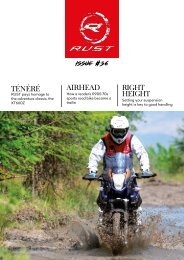RUST Magazine: RUST #43
It's been a mad couple of months (and more) since the last issue as we've been working overtime on digital projects that should come to fruition very soon. But we've taken time out to get on the bikes as often as we can. And so this issue is still a 128-page cracker – not least because we've got seriously detailed ride reports on the two of the biggest stories in Adventure in 2019 – the amazing Yamaha Tenere 700 and KTM 790 Adventure R – enduro enthusiasts might like to skip the first 40 pages... Talking of enduro, one of KTM's biggest rivals – Beta – just released some of their meanest, bestest enduros yet!
It's been a mad couple of months (and more) since the last issue as we've been working overtime on digital projects that should come to fruition very soon. But we've taken time out to get on the bikes as often as we can. And so this issue is still a 128-page cracker – not least because we've got seriously detailed ride reports on the two of the biggest stories in Adventure in 2019 – the amazing Yamaha Tenere 700 and KTM 790 Adventure R – enduro enthusiasts might like to skip the first 40 pages... Talking of enduro, one of KTM's biggest rivals – Beta – just released some of their meanest, bestest enduros yet!
Create successful ePaper yourself
Turn your PDF publications into a flip-book with our unique Google optimized e-Paper software.
LONG TERMER<br />
w<br />
biggest bugbear although I suspect the<br />
real culprit is the subframe design (JB:<br />
note that on the 2020 models the header<br />
pipe is now two-piece to make fitting so<br />
much easier). The standard shock reservoir<br />
is piston driven and it sits pretty close to<br />
the hot pipe. I changed the reservoir to<br />
a bladder system to improve the shock<br />
performance by reducing heat and<br />
improving the feel of the shock in the first<br />
part of the stroke because the bladder has<br />
no piston that has to break through the oil<br />
and therefore reduces stiction.<br />
The bad news for me was that the<br />
cannister now pretty much sits on the pipe<br />
which is less than ideal. I had to wrap the<br />
cannister in a heavy-duty heat shield. I am<br />
going to wrap the exhaust to try further<br />
reduce heat transfer.<br />
BRAKES<br />
My chosen brand for brakes is Braking and<br />
the FE350 has Braking discs and sintered<br />
pads fitted front and rear. The front disc is<br />
an oversize 270mm batfly design while the<br />
rear brake is a solid 220mm disc.<br />
DRIVETRAIN<br />
I only use Regina Z Link chains. I have<br />
not found a chain with comparative<br />
performance and longevity that compares<br />
to Regina so I tend to stick with what<br />
works. I did decide to run the stock chain<br />
on the FE350 this time round but after 40<br />
hours and a number of readjustments that<br />
were required I binned the chain and fitted<br />
my trusty Regina chain and in the equal<br />
time thereafter I have not had to make a<br />
single adjustment.<br />
I pair my chain with sprockets from<br />
Dirt Tricks and, like my chains, I use<br />
Dirt Tricks exclusively on all my bikes.<br />
There Zirconium sprockets are light and<br />
extremely tough. I have run a single<br />
front and rear sprocket over two seasons<br />
before and could have run them longer if<br />
I’d wanted. They are also pretty slick and<br />
add some panache to the bike. I chose<br />
the Zirconium rear sprockets which are<br />
comparable in weight to performance to<br />
aluminium sprockets and lighter than the<br />
twin metal designs. Dirt Tricks claim a 50%<br />
reduction in friction with the new coating<br />
and I can attest to both the longevity and<br />
minimal chain wear in comparison to its<br />
competitors.<br />
I started off with the gearing at 13:50 and<br />
am now running a 13:48 which is perfect<br />
for me. If you’ve never played around with<br />
your gearing – try it – you’ll be amazed at the<br />
change it makes in the engine characteristics<br />
and performance. Common sense sort of<br />
makes this a forgone conclusion but in my<br />
opinion the change is more noticeable than<br />
you would initially assume.<br />
ENGINE<br />
I’ve made no mods to the engine yet save for<br />
fitting a Hinson clutch. The Hinson clutch<br />
is engineered to much stricter tolerances<br />
than the mass-produced OEM clutches. This<br />
reduces drag and heat and reduces stiction<br />
to such an extent that I found I could run the<br />
350 to a much slower speed before stalling<br />
than was possible with the stock clutch.<br />
This was the one part that helped improve<br />
my riding more than any single other part I<br />
fitted.<br />
It’s time to replace the piston now and I will<br />
more than likely fit a Vertex top end kit. I’ve<br />
even been thinking about Kashima coating<br />
the new piston, and polishing the cylinder<br />
head and pairing this with a Torque Wing in<br />
the throttle body, but that’s are far as I need<br />
to go. The stock motor works well and I have<br />
opened a few strategic holes in the subframe<br />
/ airbox to allow the motor to breathe<br />
more. This did change the motor dynamics<br />
somewhat in that it was less docile after the<br />
airbox mods and the motor now reacts more<br />
sharply and is less docile up top.<br />
HANDLEBARS AND CONTROLS.<br />
I fitted the following bars throughout the test<br />
process, Renthal 998s, Twisted Engineering’s<br />
Flex Bar, Neken bars, and finally I landed on<br />
the Pro Taper Fuzion bars. I tried both the<br />
Carmichael and SX bends. If I’m running a<br />
GPS on trail rides I choose the Carmichael<br />
bend, the control area is 210 mm versus the<br />
90<br />
www.rustsports.com


